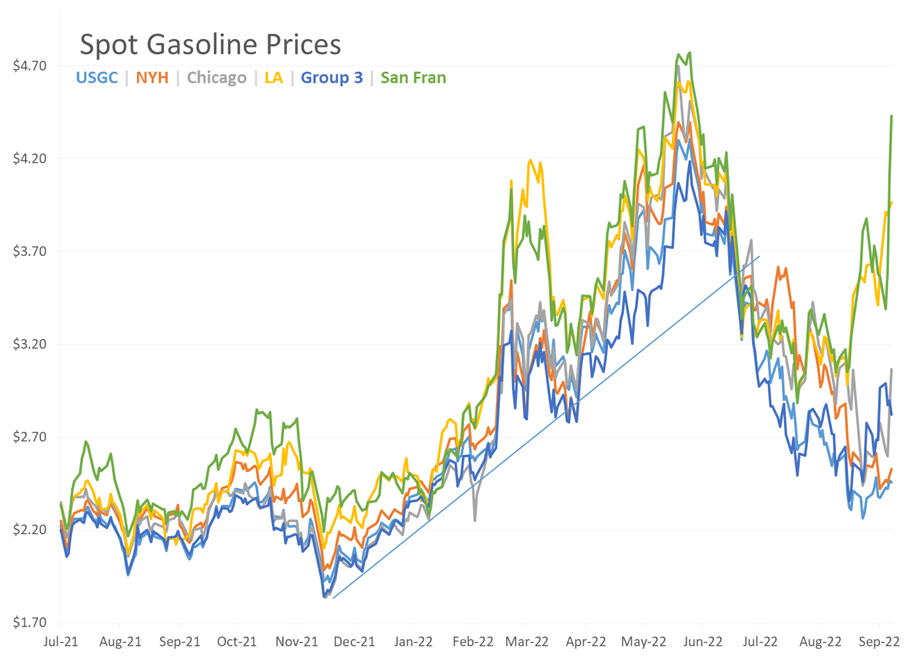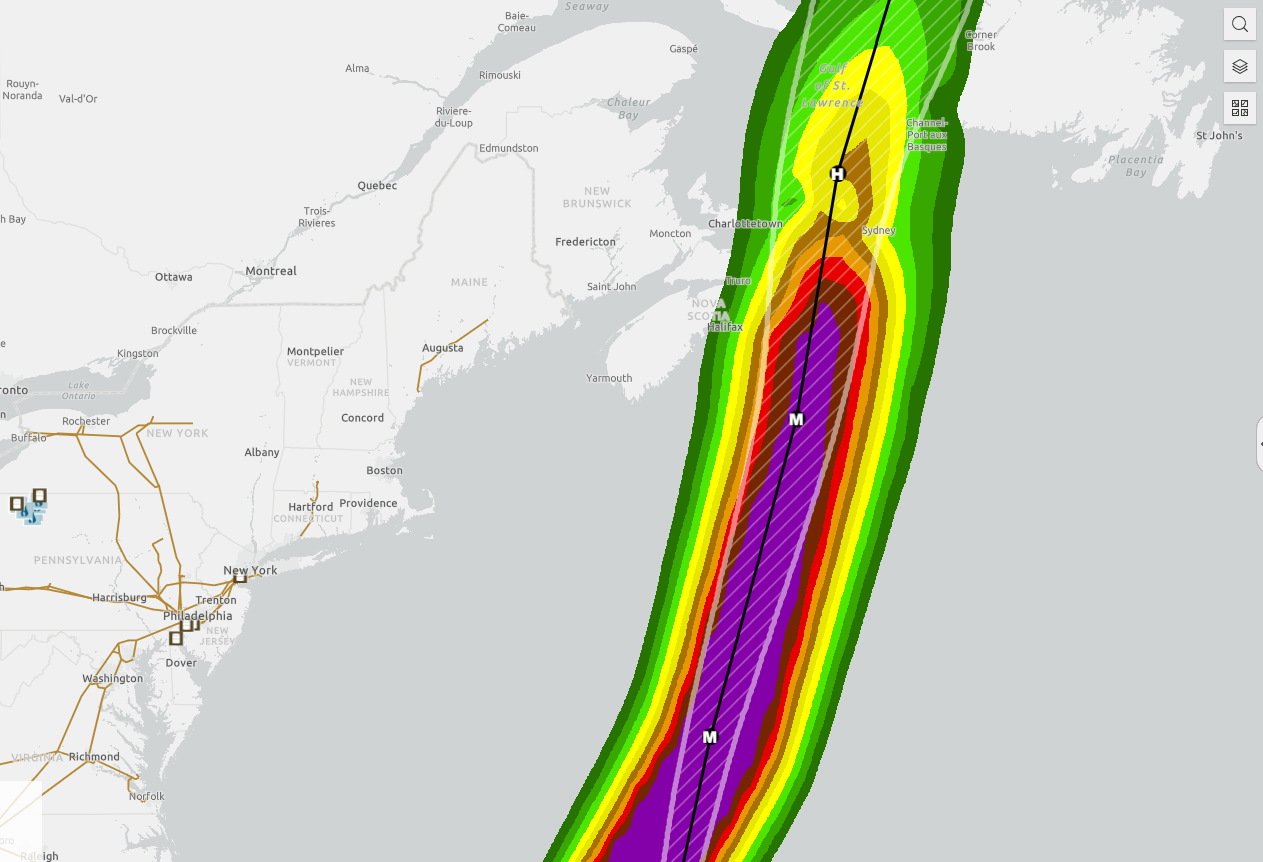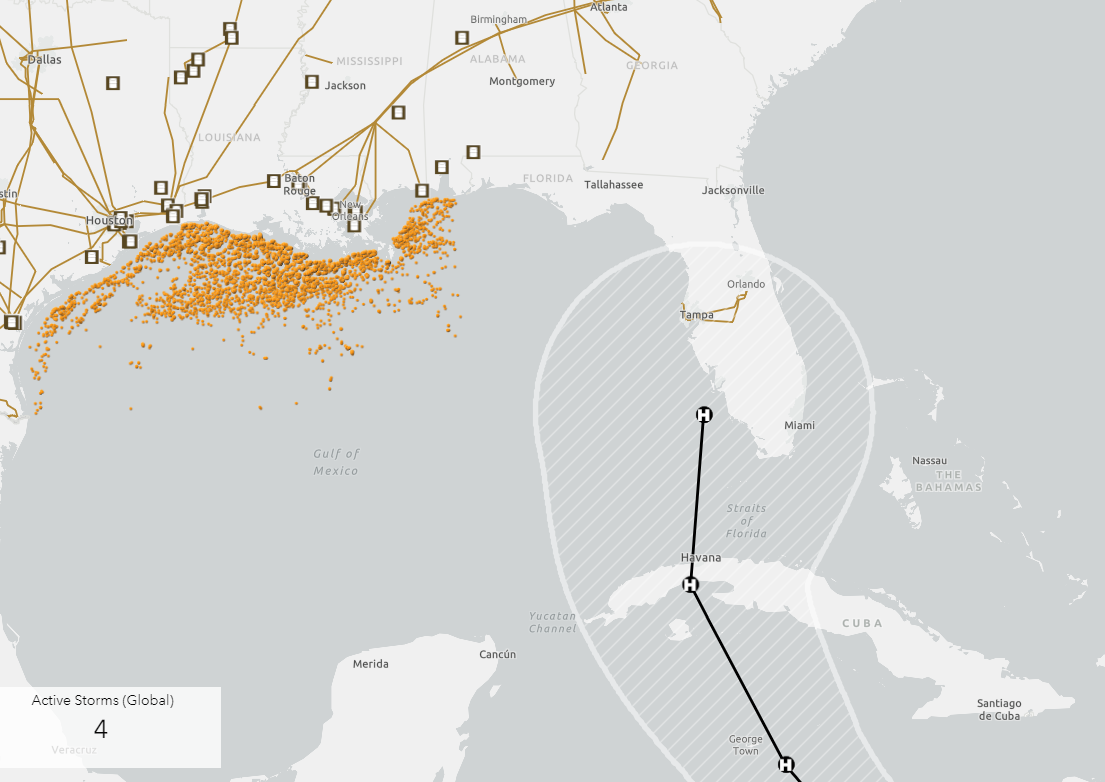Risk Taking Has Fallen Out Of Favor As Markets Around The World Fall Out Of Bed With Heavy Losses To Start Friday’s Trading

Risk taking has fallen out of favor as markets around the world fall out of bed with heavy losses to start Friday’s trading. Refined product futures are seeing heavy selling this morning, down 13 cents or more in the early going, despite signs from cash markets of supply tightness in numerous spots around the country.
Diesel prices would still finish with 10 cent gains for the week if they settled at current levels, but have dropped 20 cents from Wednesday’s high just a few ticks below the $3.50 mark. That pullback keeps a downward trend line in place that started from the August 25th high of $4.11, and would set up another test of the $3.14 range in the next week or two if prices don’t rally soon. Ordinarily, those types of swings would make for a busy year, and now we’re used to it happening in a month.
Fiona looks like it will set records as one of the strongest storms to ever hit the Canadian coast this weekend, but appears like it will stay just far enough east to avoid a hit on the Irving refinery in St. John New Brunswick. Shipping in the region will certainly be impacted as the storm blows through, but the current path appears favorable to avoid significant long term damage to ports.
The storm likely to be named Hermine was upgraded to a tropical depression overnight, and is now expected to hit south west Florida as a category 2 or 3 Hurricane Tuesday or Wednesday. The Key West and Ft. Myers are looking particularly vulnerable from the path of this system, with Cuba looking like the only thing that might slow the storm’s rapid intensification as it crosses the extremely warm waters in the Caribbean this weekend. The good news for energy supplies about this forecast path is that it keeps it well east of the oil production and refining zones in the Gulf of Mexico. That won’t prevent a surge of panic buying in Florida, but it will help resupplies once the storm has passed. Some models have this storm making additional landfalls on the east coast next week.
It’s been a rough week for refineries around the world. A fire at Husky’s refinery in Ohio killed 2 workers and has sent Chicago basis values soaring. Exxon is shutting down a refinery in France after a walkout of workers, and now Argentinian oil unions are striking after refinery explosion killed 3 workers. While none of those facilities individually will create major disruptions, they are all clear reminders of both the dangers of the industry, and the vulnerability of supply with refining capacity stretched to its limits.
Speaking of which, the West Coast continues to struggle with extremely tight supplies of gasoline that have sent basis values surging $1.50-$2 above futures and most other regional markets. A rash of refinery issues, and no options from neighboring markets for summer-grade gasoline are both contributing to the extreme price action. The big question for the next two weeks is whether or not imports are available to help alleviate this tightness, or if resupplies will have to wait until the market converts to winter-grade gasoline.
Click here to download a PDF of today's TACenergy Market Talk.
Latest Posts
Gasoline Futures Are Leading The Way Lower This Morning
The Sell-Off Continues In Energy Markets, RBOB Gasoline Futures Are Now Down Nearly 13 Cents In The Past Two Days
Week 15 - US DOE Inventory Recap
Prices To Lease Space On Colonial’s Main Gasoline Line Continue To Rally This Week
Social Media
News & Views
View All
Gasoline Futures Are Leading The Way Lower This Morning
It was a volatile night for markets around the world as Israel reportedly launched a direct strike against Iran. Many global markets, from equities to currencies to commodities saw big swings as traders initially braced for the worst, then reversed course rapidly once Iran indicated that it was not planning to retaliate. Refined products spiked following the initial reports, with ULSD futures up 11 cents and RBOB up 7 at their highest, only to reverse to losses this morning. Equities saw similar moves in reverse overnight as a flight to safety trade soon gave way to a sigh of relief recovery.
Gasoline futures are leading the way lower this morning, adding to the argument that we may have seen the spring peak in prices a week ago, unless some actual disruption pops up in the coming weeks. The longer term up-trend is still intact and sets a near-term target to the downside roughly 9 cents below current values. ULSD meanwhile is just a nickel away from setting new lows for the year, which would open up a technical trap door for prices to slide another 30 cents as we move towards summer.
A Reuters report this morning suggests that the EPA is ready to announce another temporary waiver of smog-prevention rules that will allow E15 sales this summer as political winds continue to prove stronger than any legitimate environmental agenda. RIN prices had stabilized around 45 cents/RIN for D4 and D6 credits this week and are already trading a penny lower following this report.
Delek’s Big Spring refinery reported maintenance on an FCC unit that would require 3 days of work. That facility, along with several others across TX, have had numerous issues ever since the deep freeze events in 2021 and 2024 did widespread damage. Meanwhile, overnight storms across the Midwest caused at least one terminal to be knocked offline in the St. Louis area, but so far no refinery upsets have been reported.
Meanwhile, in Russia: Refiners are apparently installing anti-drone nets to protect their facilities since apparently their sling shots stopped working.
Click here to download a PDF of today's TACenergy Market Talk.

The Sell-Off Continues In Energy Markets, RBOB Gasoline Futures Are Now Down Nearly 13 Cents In The Past Two Days
The sell-off continues in energy markets. RBOB gasoline futures are now down nearly 13 cents in the past two days, and have fallen 16 cents from a week ago, leading to questions about whether or not we’ve seen the seasonal peak in gasoline prices. ULSD futures are also coming under heavy selling pressure, dropping 15 cents so far this week and are trading at their lowest level since January 3rd.
The drop on the weekly chart certainly takes away the upside momentum for gasoline that still favored a run at the $3 mark just a few days ago, but the longer term up-trend that helped propel a 90-cent increase since mid-December is still intact as long as prices stay above the $2.60 mark for the next week. If diesel prices break below $2.50 there’s a strong possibility that we see another 30 cent price drop in the next couple of weeks.
An unwind of long positions after Iran’s attack on Israel was swatted out of the sky without further escalation (so far anyway) and reports that Russia is resuming refinery runs, both seeming to be contributing factors to the sharp pullback in prices.
Along with the uncertainty about where the next attacks may or may not occur, and if they will have any meaningful impact on supply, come no shortage of rumors about potential SPR releases or how OPEC might respond to the crisis. The only thing that’s certain at this point, is that there’s much more spare capacity for both oil production and refining now than there was 2 years ago, which seems to be helping keep a lid on prices despite so much tension.
In addition, for those that remember the chaos in oil markets 50 years ago sparked by similar events in and around Israel, read this note from the NY Times on why things are different this time around.
The DOE’s weekly status report was largely ignored in the midst of the big sell-off Wednesday, with few noteworthy items in the report.
Diesel demand did see a strong recovery from last week’s throwaway figure that proves the vulnerability of the weekly estimates, particularly the week after a holiday, but that did nothing to slow the sell-off in ULSD futures.
Perhaps the biggest next of the week was that the agency made its seasonal changes to nameplate refining capacity as facilities emerged from their spring maintenance.
PADD 2 saw an increase of 36mb/day, and PADD 3 increased by 72mb/day, both of which set new records for regional capacity. PADD 5 meanwhile continued its slow-motion decline, losing another 30mb/day of capacity as California’s war of attrition against the industry continues. It’s worth noting that given the glacial pace of EIA reporting on the topic, we’re unlikely to see the impact of Rodeo’s conversion in the official numbers until next year.
Speaking of which, if you believe the PADD 5 diesel chart below that suggests the region is running out of the fuel, when in fact there’s an excess in most local markets, you haven’t been paying attention. Gasoline inventories on the West Coast however do appear consistent with reality as less refining output and a lack of resupply options both continue to create headaches for suppliers.





